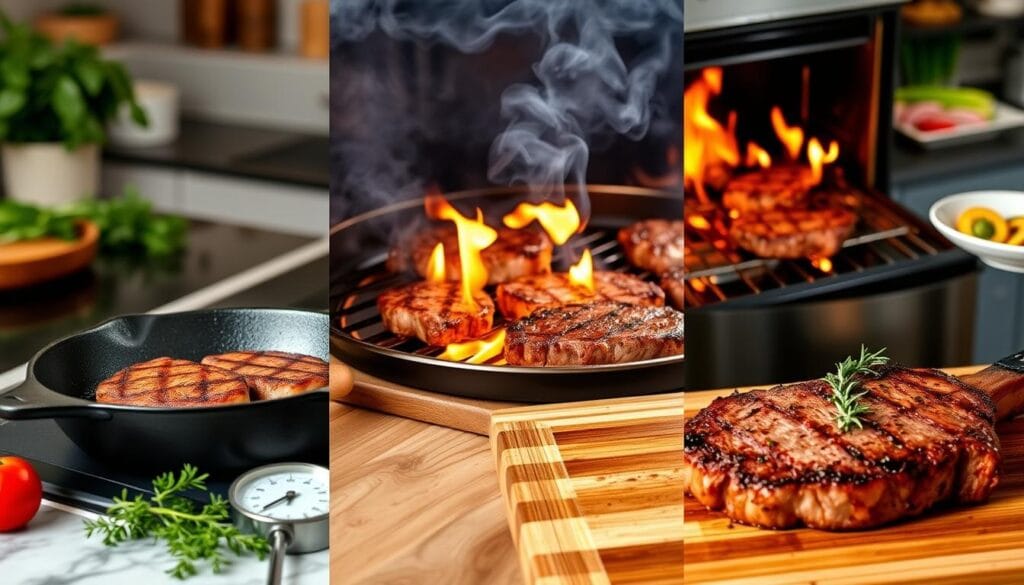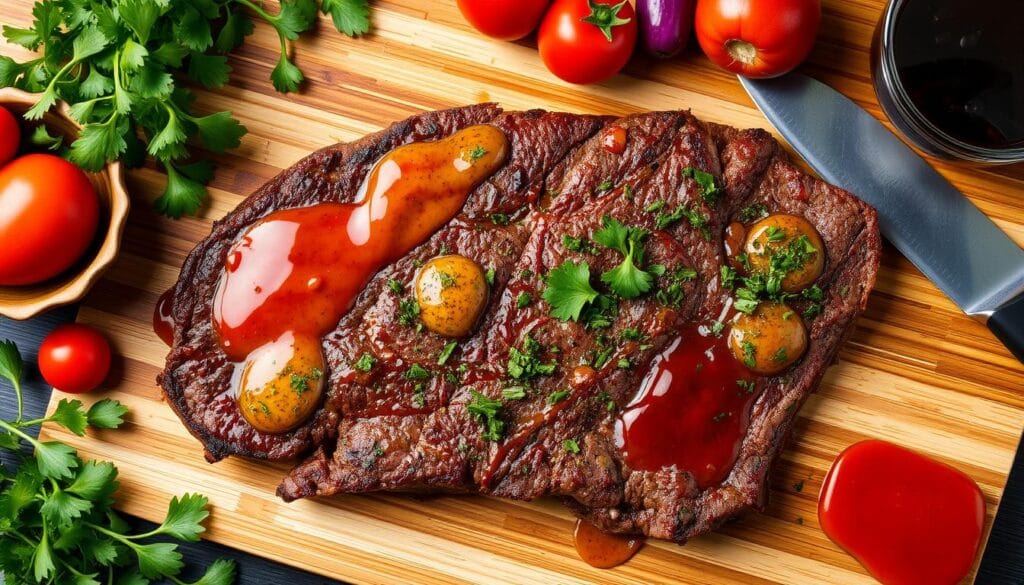Every home cook dreams of serving a steak that tastes like it’s from a restaurant. The flat iron steak is a hidden gem that can make your dinner special. It’s tender and full of flavor, turning a simple meal into a memorable one.
Imagine cutting into a perfectly cooked flat iron steak. Its juicy inside and crispy edges will make your mouth water. Whether you’re new to cooking or have been doing it for years, learning to cook flat iron steak will impress everyone.
This guide will teach you how to make a delicious flat iron steak. You’ll learn how to pick the right cut and cook it perfectly. Soon, you’ll be a pro at making flat iron steak that’s as good as any steakhouse.
Key Takeaways
- Flat iron steak offers exceptional tenderness and flavor
- Medium-rare is the optimal cooking temperature
- Proper preparation is crucial for restaurant-quality results
- High-heat cooking techniques maximize flavor and texture
- Room temperature meat ensures even cooking
Understanding Flat Iron Steak’s Unique Characteristics
Discover the hidden gem of beef cuts that butchers have long kept as their secret weapon. The flat iron steak is a remarkable balance of flavor, tenderness, and value. It stands out from other beef cuts.
Why Flat Iron Steak is Called the Butcher’s Choice
Professional butchers love this cut for several compelling reasons. It comes from the chuck primal. The flat iron steak offers exceptional qualities that make it a true butcher’s choice:
- Nearly as tender as tenderloin
- Significantly more affordable
- Rich, robust flavor profile
- Versatile cooking methods
Meat Grading and Marbling Explained
Understanding meat grading helps you select the perfect steak. The USDA Prime grade is the gold standard, showing the highest marbling. Marbling is the fat within the muscle. It impacts flavor and tenderness.
| Beef Grade | Marbling Level | Flavor Profile |
|---|---|---|
| USDA Prime | Extensive | Exceptional |
| USDA Choice | Moderate | Very Good |
| USDA Select | Minimal | Good |
Anatomy and Cut Location
The flat iron steak comes from the chuck, specifically the shoulder area of the cow. This location contributes to its unique characteristics. In 2002, researchers at the University of Nebraska discovered a technique to remove tough connective tissue. This enhances the steak’s natural tenderness.
“A great steak is about understanding its origin and treating it with respect.” – Chef’s wisdom
When selecting a flat iron steak, look for consistent marbling and a rich, deep color. These signs indicate quality meat grading. Your butcher can help you choose the best cut for your culinary adventure.
Essential Kitchen Tools and Equipment
Preparing a delicious flat iron steak needs more than just good meat. Your kitchen tools are key to getting restaurant-quality results. The right tools can turn a simple meal into a culinary work of art.
- Cast iron skillet (great for keeping heat)
- Precise meat thermometer
- Long-handled tongs
- Sharp chef’s knife
- Cutting board with juice groove
Professional chefs say investing in top-notch grilling accessories is crucial. The right tools can make a big difference in your cooking.
A great pan is like a painter’s brush – it can make all the difference in creating a masterpiece.
Now, let’s look at the most important tools for steak preparation:
| Tool | Purpose | Pro Tip |
|---|---|---|
| Cast Iron Skillet | Even heat distribution | Preheat for 5-7 minutes before cooking |
| Instant-Read Thermometer | Check internal temperature | Insert sideways for most accurate reading |
| Flexible Spatula | Flipping without damaging meat | Use thin, flexible design for gentle handling |
Professional chefs see grilling accessories as part of their skill. Choose tools that help you control temperature, manage moisture, and get that perfect sear every time.
Remember, investing in quality steak cooking tools is an investment in your culinary experience. Each piece of kitchen equipment helps create a memorable dining moment.
Selecting the Perfect Flat Iron Steak
Choosing the right flat iron steak can make your meal special. Knowing how to pick the best cut is key.
What to Look for When Buying
When picking a steak, look for these things:
- Look for consistent marbling throughout the cut
- Check for bright red color without brown spots
- Ensure the meat appears firm and moist
- Inspect the surface for minimal excess liquid
Grass-fed vs. Grain-fed Options
There are two main types of flat iron steak:
| Grass-Fed Beef | Grain-Fed Beef |
|---|---|
| Leaner meat | More marbling |
| Stronger, earthier flavor | Milder, more traditional taste |
| Higher omega-3 content | More consistent texture |
Ideal Thickness and Size
Steak thickness is important for cooking. For flat iron steaks, aim for cuts around 1 inch thick. This size ensures:
- Even heat distribution
- Perfect internal temperature
- Reduced risk of overcooking
- Maintaining juicy texture
“The secret to a great steak is not just in the cooking, but in the selection.” – Professional Chef
Flat iron steaks usually weigh between 8 to 12 ounces. Choosing the right size means you’ll have a meal that’s both filling and healthy.
Preparation Methods and Seasoning Techniques
Preparing a flat iron steak needs careful attention to seasoning and preparation. This cut is tender and flavorful, loved by both home cooks and chefs.
Your seasoning approach can turn a simple cut into a gourmet meal. Begin by letting the steak warm up to room temperature. This ensures it cooks evenly and absorbs flavors better.
Essential Seasoning Techniques
- Use kosher salt generously to enhance natural meat flavors
- Freshly ground black pepper adds depth and complexity
- Experiment with dry rub combinations like garlic powder and smoked paprika
- Consider light marinades for additional flavor profiles
“The key to great steak is simple: respect the meat and season wisely.”
Choosing a marinade wisely is key. A short marinade can make your steak taste amazing without hiding its natural flavor. The steak’s tenderness means you don’t need to marinate it for hours.
Pro Seasoning Tips
- Pat the steak dry before applying seasonings
- Let seasonings sit for 15-30 minutes before cooking
- Avoid commercial seasonings that mask the meat’s natural flavor
- Use fresh herbs for an extra flavor boost
The aim of seasoning is to enhance the meat’s flavor, not overpower it. With these tips, you’ll make a perfectly seasoned flat iron steak that wows everyone.
Mastering the Perfect Temperature
Cooking the perfect flat iron steak needs precision and knowing about steak temperature. Getting the right temperature is key to making a great meal. It turns a simple cut into a top-notch dish.
Start by getting your steak ready before cooking. Let it sit at room temperature for 45-60 minutes. This helps it cook evenly and better when you use a meat thermometer.
Room Temperature Guidelines
- Remove steak from refrigerator 45-60 minutes before cooking
- Place on a clean plate at room temperature
- Pat dry with paper towels to remove excess moisture
- Season after reaching room temperature
Optimal Cooking Temperatures
Knowing about cooking doneness is crucial for your perfect steak. Each temperature gives a different taste and texture.
| Doneness Level | Internal Temperature | Texture |
|---|---|---|
| Rare | 125°F | Very soft, red center |
| Medium Rare | 135°F | Soft, pink center |
| Medium | 145°F | Slightly firm, light pink center |
| Medium Well | 150°F | Firmer, slight pink center |
| Well Done | 160°F | Firm, no pink |
Using Meat Thermometers Effectively
A good meat thermometer is essential for perfect steak temperature. Stick the probe into the thickest part of the steak. Make sure it’s not in fat or bone for accurate readings.
“The difference between a good steak and a great steak is often just a few degrees.” – Professional Chef
Pro tip: Remember, the steak’s temperature will rise 5-10 degrees while it rests. Take it off the heat a bit before it reaches your desired doneness. This prevents it from getting overcooked.
Three Best Cooking Methods for Flat Iron Steak
Cooking a flat iron steak needs skill and precision. The right methods can turn this affordable cut into a top-notch meal. Let’s look at the three best ways to cook it.

Grilling: The Outdoor Flavor Champion
Grilling is the best way to cook flat iron steak. It adds a smoky flavor that meat lovers love. Here’s how to do it:
- Preheat grill to 450-500°F
- Cook 5 minutes per side for medium-rare
- Flip only once to maintain perfect sear
Pan-Searing: The Indoor Perfection Method
Pan-searing makes a great crust that keeps the steak juicy. A cast-iron skillet is the best tool for this:
- Use high heat with a touch of oil
- Sear 3-4 minutes per side
- Aim for internal temperature of 145°F
Broiling: Quick and Efficient
Broiling is a fast option when you can’t grill outside. It gives great results quickly:
- Position oven rack 4-5 inches from broiler
- Cook 6 minutes per side
- Watch carefully to prevent overcooking
“The key to perfect flat iron steak is high heat and minimal flipping.” – Professional Chef’s Tip
| Cooking Method | Cooking Time | Heat Level | Best For |
|---|---|---|---|
| Grilling | 5 minutes per side | 450-500°F | Smoky flavor |
| Pan-Searing | 3-4 minutes per side | High heat | Perfect crust |
| Broiling | 6 minutes per side | High oven setting | Quick cooking |
Pro tip: Always slice your flat iron steak against the grain to ensure maximum tenderness.
Creating Restaurant-Style Sear and Crust
Making a perfect steak is an art that starts with searing techniques. The secret to a great flat iron steak is a flavorful crust. This crust highlights the meat’s natural taste.
The magic of a perfect steak comes from the Maillard reaction. This process turns the meat’s surface into a golden-brown crust. It’s packed with complex flavors. To make this culinary masterpiece, follow a few key steps:
Pan-Searing Techniques
- Choose a heavy-bottomed cast iron skillet for optimal heat retention
- Ensure the pan is smoking hot before adding the steak
- Use high smoke-point oils like avocado or grapeseed
- Pat the steak completely dry to promote better crust formation
Achieving the Perfect Char
For an exceptional sear, follow these professional techniques:
- Preheat your skillet until it’s extremely hot
- Season the steak generously with salt and pepper
- Sear for 3-4 minutes on each side without moving the steak
- Add butter, garlic, and herbs in the final minute of cooking
“The secret to a perfect steak is patience and high heat” – Professional Chef
Pro tip: For an extra flavor boost, baste the steak with melted butter and aromatic herbs during the final moments of cooking. This technique enhances the crust formation and adds depth to the Maillard reaction’s complex flavor profile.
Essential Resting and Slicing Guidelines
Learning how to rest and slice your steak can make any meal special. After cooking, it’s key to let your flat iron steak rest. This helps keep it juicy and flavorful.
“Patience is the secret ingredient to a perfectly tender steak.” – Professional Chef
Many home cooks forget the importance of steak resting. When you take the steak off the heat, its temperature keeps rising. Letting it rest for 5-10 minutes helps the juices spread evenly. This makes every bite tender and juicy.
Resting Time Guidelines
- Thin steaks (1/2 inch): Rest 3-5 minutes
- Medium steaks (1 inch): Rest 5-7 minutes
- Thick steaks (1.5 inches): Rest 8-10 minutes
When slicing your steak, cutting against the grain is crucial. This method makes the meat tender and easy to chew. Look for the muscle fibers and slice across them.
Cutting Against the Grain: Step-by-Step
- Identify muscle fiber direction
- Position knife perpendicular to fibers
- Make thin, consistent slices
- Use a sharp knife for clean cuts
| Steak Cut | Grain Direction | Recommended Slice Thickness |
|---|---|---|
| Flat Iron | Pronounced parallel lines | 1/4 to 1/2 inch |
| Skirt Steak | Very distinct long fibers | 1/4 inch |
| Rib-eye | Fine, less defined grain | 1/2 inch |
Pro tip: Always let your steak rest on a cutting board with a slight tilt. This allows excess juices to drain, preventing a soggy bottom.
Complementary Sauces and Marinades
To make your flat iron steak truly special, learn about the best steak sauces and marinades. These can take your dish from good to amazing. They add depth and complexity to every bite.

Improving flavor starts with knowing how ingredients work with your steak. A good marinade tenderizes the meat and adds incredible taste.
Classic Steak Sauce Recipes
Here are some amazing sauces for your flat iron steak:
- Chimichurri Sauce: A lively Argentine favorite with:
- 1 cup fresh Italian parsley
- 1/4 cup fresh oregano leaves
- 1/2 cup extra virgin olive oil
- 1/3 cup red wine vinegar
- 4 cloves garlic
- 1 teaspoon crushed red pepper flakes
- Béarnaise Sauce: A creamy, buttery French delight
- Herb Butter: Easy to make and full of flavor
Marinade Options for Enhanced Flavor
Try these marinade mixes for a flavor boost:
- Honey Balsamic Marinade
- Balsamic vinegar (tenderizes meat)
- Honey (adds caramelization)
- Dijon mustard (gives a zesty taste)
- Olive oil
- Salt and pepper to taste
“The secret to a perfect marinade is balance – it should enhance, not overpower the steak’s natural flavor.”
Marinate your flat iron steak for 30 minutes to several hours. Don’t marinate too long, as it can make the meat tough. A short marinade usually gives the best flavor.
Side Dish Pairings and Serving Suggestions
Improving your flat iron steak meal is more than just cooking it right. The right sides can make your meal amazing. Choosing the right vegetable and starch sides is key. It’s all about matching flavors and textures.
When picking sides, aim for a mix of colors, nutrients, and tastes. You want a plate that shows off the steak’s rich flavor.
Top Vegetable Pairings
- Roasted asparagus with garlic
- Grilled Brussels sprouts with balsamic glaze
- Sautéed mushrooms with thyme
- Honey-glazed baby carrots
Starch Accompaniments
- Creamy garlic mashed potatoes
- Herb-infused quinoa
- Crispy rosemary roasted potatoes
- Wild rice pilaf
Recent studies show that 43 different side dishes can go well with steak. Favorites include cucumber salad, panzanella salad, and fruit salad.
“A well-chosen side dish doesn’t just accompany a steak—it completes the culinary story.” – Professional Chef
Tip: Cut your steak against the grain and serve it on a bed of arugula or mixed greens. This makes the steak look better and adds a peppery taste.
Storage and Leftover Management
Keeping your flat iron steak’s flavor fresh is key. After you’ve enjoyed your meal, you’ll want to make the most of any leftover meat.
- Place steak in an airtight container
- Refrigerate within 2 hours of cooking
- Store for up to 4 days maximum
Choosing the right way to reheat your steak is crucial. You want to warm it up without drying it out or overcooking it.
| Reheating Method | Temperature | Time |
|---|---|---|
| Oven | 250°F | 15-20 minutes |
| Skillet | Low heat | 1-2 minutes per side |
Pro tip: For cold leftover steak, try slicing it thinly. Use it in salads, sandwiches, or wraps to keep it tender and flavorful.
“The secret to great leftover steak is gentle reheating and creative repurposing.” – Chef Billy Parisi
If you can’t eat the steak in 4 days, freezing is a good choice. Wrap it tightly in freezer paper or vacuum-seal it to avoid freezer burn. Frozen steak can stay good for up to 3 months.
Conclusion
Mastering flat iron steak preparation is an art that turns a simple meal into a special culinary journey. By using the right cooking techniques, you can bring out the best in this versatile cut. This makes it possible to create dishes that rival those from top restaurants, all from your own kitchen.
The secret to enjoying your steak starts with choosing high-quality meat and using smart cooking methods. Whether you pick grass-fed or grain-fed, or perfect your searing skills, each step adds to a great dining experience. Don’t forget the importance of seasoning, temperature control, and letting the steak rest properly. These details make all the difference between a good steak and an unforgettable one.
By following these tips, you can turn flat iron steak into the star of your meal. Whether you grill, pan-sear, or use sous vide, your skills will always result in delicious steaks. Start your journey in flat iron steak preparation with confidence. You’ll soon enjoy making perfectly cooked, tasty steaks every time.
Table of Contents
FAQ
What is a flat iron steak?
How should I cook a flat iron steak for the best results?
What’s the best way to season a flat iron steak?
How do I choose a quality flat iron steak?
What are the best cooking methods for flat iron steak?
How should I slice and serve flat iron steak?
How do I store leftover flat iron steak?
What internal temperature is best for flat iron steak?
Can I use a marinade with flat iron steak?
Leave us a comment if you like the recipe
There are no reviews yet. Be the first one to write one.
